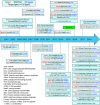The PROTAC technology in drug development
- PMID: 30604499
- PMCID: PMC6590639
- DOI: 10.1002/cbf.3369
The PROTAC technology in drug development
Abstract
Currently, a new technology termed PROTAC, proteolysis targeting chimera, has been developed for inducing the protein degradation by a targeting molecule. This technology takes advantage of a moiety of targeted protein and a moiety of recognizing E3 ubiquitin ligase and produces a hybrid molecule to specifically knock down a targeted protein. During the first decade, three pedigreed groups worked on the development of this technology. To date, this technology has been extended by different groups, aiming to develop new drugs against different diseases including cancers. This review summarizes the contributions of the groups for the development of PROTAC. SIGNIFICANCE OF THE STUDY: This review summarized the development of the PROTAC technology for readers and also presented the author's opinions on the application of the technology in tumor therapy.
Keywords: PROTAC; cancer; drug development; protein degradation; small molecule.
© 2019 The Authors Cell Biochemistry and Function Published by John Wiley & Sons Ltd.
Conflict of interest statement
There are no other conflicts of interest to disclose.
Figures





Similar articles
-
Recent Advances in PROTACs for Drug Targeted Protein Research.Int J Mol Sci. 2022 Sep 7;23(18):10328. doi: 10.3390/ijms231810328. Int J Mol Sci. 2022. PMID: 36142231 Free PMC article. Review.
-
[Advances in the preclinical and clinical research of proteolysis targeting chimera].Sheng Wu Gong Cheng Xue Bao. 2023 Sep 25;39(9):3615-3627. doi: 10.13345/j.cjb.221040. Sheng Wu Gong Cheng Xue Bao. 2023. PMID: 37805842 Review. Chinese.
-
New strategy for renal fibrosis: Targeting Smad3 proteins for ubiquitination and degradation.Biochem Pharmacol. 2016 Sep 15;116:200-9. doi: 10.1016/j.bcp.2016.07.017. Epub 2016 Jul 26. Biochem Pharmacol. 2016. PMID: 27473774
-
Proteolysis-targeting chimeras (PROTACs) in cancer therapy.Mol Cancer. 2022 Apr 11;21(1):99. doi: 10.1186/s12943-021-01434-3. Mol Cancer. 2022. PMID: 35410300 Free PMC article. Review.
-
Current Challenges in Small Molecule Proximity-Inducing Compound Development for Targeted Protein Degradation Using the Ubiquitin Proteasomal System.Molecules. 2022 Nov 22;27(23):8119. doi: 10.3390/molecules27238119. Molecules. 2022. PMID: 36500212 Free PMC article. Review.
Cited by
-
Proteolysis targeting chimera technology: a novel strategy for treating diseases of the central nervous system.Neural Regen Res. 2021 Oct;16(10):1944-1949. doi: 10.4103/1673-5374.308075. Neural Regen Res. 2021. PMID: 33642364 Free PMC article. Review.
-
MDM2-Based Proteolysis-Targeting Chimeras (PROTACs): An Innovative Drug Strategy for Cancer Treatment.Int J Mol Sci. 2022 Sep 21;23(19):11068. doi: 10.3390/ijms231911068. Int J Mol Sci. 2022. PMID: 36232374 Free PMC article. Review.
-
Targeted protein degradation in mammalian cells: A promising avenue toward future.Comput Struct Biotechnol J. 2022 Sep 28;20:5477-5489. doi: 10.1016/j.csbj.2022.09.038. eCollection 2022. Comput Struct Biotechnol J. 2022. PMID: 36249565 Free PMC article. Review.
-
Development of a novel PROTAC using the nucleic acid aptamer as a targeting ligand for tumor selective degradation of nucleolin.Mol Ther Nucleic Acids. 2022 Sep 19;30:66-79. doi: 10.1016/j.omtn.2022.09.008. eCollection 2022 Dec 13. Mol Ther Nucleic Acids. 2022. PMID: 36250201 Free PMC article.
-
Bromodomain and BET family proteins as epigenetic targets in cancer therapy: their degradation, present drugs, and possible PROTACs.RSC Adv. 2020 Dec 24;11(2):612-636. doi: 10.1039/d0ra07971e. eCollection 2020 Dec 24. RSC Adv. 2020. PMID: 35746919 Free PMC article. Review.
References
-
- Mansour MA. Ubiquitination: friend and foe in cancer. Int J Biochem Cell Biol. 2018;101:80‐93. - PubMed
-
- Zhou P, Bogacki R, McReynolds L, Howley PM. Harnessing the ubiquitination machinery to target the degradation of specific cellular proteins. Mol Cell. 2000;6(3):751‐756. - PubMed
-
- Sakamoto KM. Chimeric molecules to target proteins for ubiquitination and degradation. Methods Enzymol. 2005;399:833‐847. - PubMed
Publication types
MeSH terms
Substances
Grants and funding
LinkOut - more resources
Full Text Sources
Other Literature Sources
Research Materials

